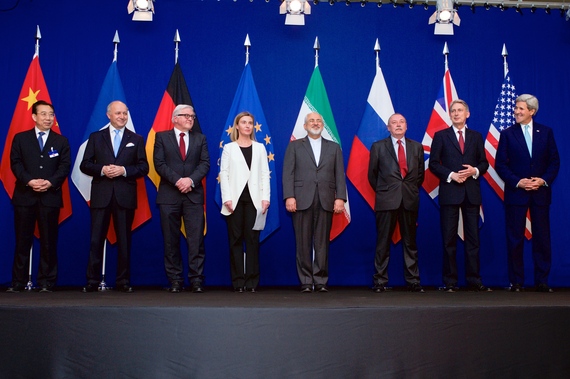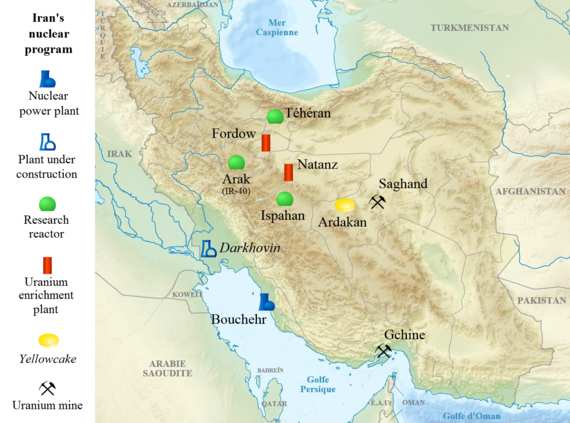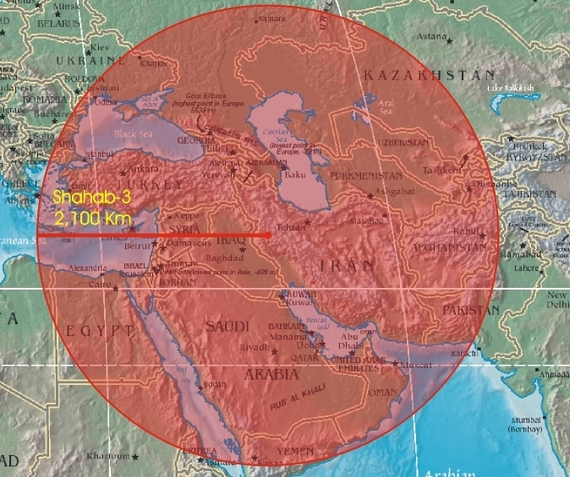On April 2, in Lausanne Switzerland, the foreign affairs ministers of Germany, France, the United Kingdom, the European Union and Iran, as well as the U.S. Secretary of State, John Kerry, along with Russian, and Chinese diplomats, announced they had reached agreement on a framework for a broader, comprehensive agreement, over the Iranian nuclear program. The final agreement, expected by the end of June, would require additional "technical details" to be resolved. Not surprisingly, the announcement triggered a media frenzy.
Supporters and critics of the Obama administration quickly lined up to hail "the historic agreement" as the "only alternative to war" or condemn it as "inadequate" and "legitimating Iran's quest for nuclear weapons." Regardless of one's assessment of the "framework" that was announced in Lausanne, it's clear that the agreement, if successfully implemented, will redefine the political dynamic of the Middle East.
Iran's Nuclear Program
The key terms of the agreement will require Iran to limit its activity to enrich uranium and reduce its existing stockpile. In addition, the heavy water "research reactor" at Arak will be redesigned so that it will not produce plutonium as a byproduct of its operations. Enrichment activity will be limited to the facility at Natanz and it, along with all other non-military installations involved in nuclear research or development, will be subject to inspection by the International Atomic Energy Agency. The number of gas centrifuges used to enrich uranium will be reduced from 19,000 to 6,104 for 10 years. Of these, 5,060 will be the less efficient, first generation, centrifuges.
Uranium 235, the isotope that is employed by a nuclear reactor and the fissionable material around which atomic bombs are built, makes up approximately 0.7 percent of the uranium oxide produced from refining uranium ore. The other 99.3 percent consists of Uranium 238. To isolate U-235, uranium oxide is treated with fluoride and converted to the gas uranium hexafluoride. It is then processed at low temperature through a series of gas centrifuges to increase its concentration. The typical nuclear reactor requires U-235 concentrated to between three percent and five percent. Weapons grade U-235 must be concentrated to a level of 90 percent.
In addition, Iran's existing supply of enriched uranium will be reduced by 97 percent, from 10,000 kg to 300 kg. That stockpile has been enriched to varying levels of up to 20 percent, although, it is believed, only about 200 kg has been enriched to that level. The remaining stockpile, if it were further enriched, assuming it was already at the 20 percent level, would be sufficient to produce enough fissile material for two or three atomic bombs. The composition of the permitted stockpile of 300 kg is another one of the "technical" issues to be resolved. Iran has agreed that for the next 15 years it will not enrich its stockpile of uranium higher than 3.67 percent, the level it needs to fuel its nuclear power reactor.
There are two ways for Iran to obtain enough fissile material to construct bombs. One way is to enrich uranium 235 to a level of 90 percent. The other is to divert plutonium produced as a byproduct of the operation of the heavy water "research reactor" in Arak. The agreement will prevent Iran for utilizing either source. In addition, Iran has agreed that no spent nuclear fuel will be reprocessed in Iran, and all spent fuel rods will be exported to a third party, most likely Russia, for reprocessing. The Fodrow nuclear facility, currently the second facility where enrichment is taking place, will be converted to a civilian research facility for nuclear physics and technology.
The agreement leaves a lot of questions unanswered. These are the "technical" issues that are going to be the subject of further deliberations and which are slated to be concluded by the end of June. For example, what will Iran do with the balance of its gas centrifuges? Will it decommission them or rotate them into use while still keeping below the agreed upon level of 6,104 units? The question is an important one.
Gas centrifuges are extremely sensitive pieces of equipment. It's unlikely they can be mothballed for 10 or more years and then simply reactivated in the future. This equipment is extremely hard to procure and subject to extensive export controls. It is not easily replaceable. How Iran treats this equipment has an important bearing on its ability to reactivate or enlarge the program at a later date.
Moreover, Iran has not agreed to end its research on developing nuclear weapons and military research facilities are specifically excluded from inspection by the IAEA. In addition, the agreement has no bearing on Iran's missile arsenal or its continued development of longer range ballistic missiles, their guidance systems or their accompanying warheads.
Iran's Nuclear Program: A Credible Threat?
To be a full member of the "Nuclear Club" you need four key items. First of all, you need an atomic device. Secondly you need a credible ability to deliver that device to its intended target. In this day and age that means a missile. In theory one could load up an atomic bomb on a truck and just drive it to its destination and then detonate it. Suspense thrillers are full of all kinds of innovative ways of delivering an atomic bomb.
In Tom Clancy's The Sum of all Fears, an atomic bomb was hidden in a vending machine and was detonated at a stadium while hosting a Super Bowl. In real life, however, a missile is the best way to deliver an atomic device.
In turn missiles require two more critical items: a guidance system and a warhead miniaturized to a size where it can fit on a missile. Despite claims, most notably from Israeli Prime Minister Benjamin Netanyahu that Iran is only a "year or two" away from developing a deliverable atomic device (a claim that he has made for the last 10 years) the reality is that Iran still has a long way to go before it can have a credible nuclear threat.
It's conceivable that Iran could, in the space of a year or two, enrich enough uranium 235 to the 90 percent level required in an atomic bomb. Depending on the design and yield of that device, that would require between 8 and 16 kg of fissile material. This would create a bomb with a yield of between 20 and 30 kilotons, roughly comparable to the bomb dropped on Hiroshima. Even that goal, however, is no trivial task and would still require Iran to design and test a bomb and perfect a delivery mechanism.
Iran has developed a medium range ballistic missile, the Shahab-3, with a, presumed, maximum range of around 1,200 miles. This would be sufficient to target a broad circumference around Iran that would encompass Cairo, Istanbul and the entire Arabian Peninsula, and would extend eastward all the way to New Delhi. The Shahab, which means meteor in Farsi, was based on the North Korean Nodong-1, which in turn was based on the Soviet SS-1 or "Scud" missile.
The Shahab has a number of variants and has been steadily improved. It has a sophisticated rocket nozzle control system that allows it to change its trajectory in order to prevent early warning radar from providing a trajectory prediction to guide interceptor missiles. The missile's CEP (circular error probability) is between 100 and 200 feet. That means it would be expected to hit within a 200 foot radius of the intended target 95 percent of the time.
For pinpoint targeting of military objectives with conventional munitions, that's not very accurate. For an atomic weapon of mass destruction launched at a city, it is accurate enough. It is unclear how effective the guidance system of the Shahab-3 is at long distances, however, or how it would operate in a battlefield situation.
A variant of the Shahab-3 called the Ghadr-110 has a comparable range but requires a set up time of only 30 minutes. Significantly, on March 8, Iran unveiled a new cruise missile, the Soumar, with a range of between 1,200 and 1,800 miles. The Soumar is capable of carrying a 400 to 500 pound nuclear warhead. It is based on the Soviet era HK-55 (AS-25) missile. Western intelligence agencies believed that the Soumar was reverse engineered from a dozen HK-55 that Iran obtained illegally from Ukraine in 2001.
The final element of a credible nuclear threat is the ability to miniaturize an atomic device so that it can be delivered by a ballistic missile. The original Hiroshima bomb, "Little Boy" weighted approximately five tons. A warhead of comparable explosive force would have to weigh less than 500 pounds to be able to fit on a ballistic missile. Despite occasional news reports that Iran has already learned how to miniaturize a nuclear warhead, as of April 2015, there is no evidence that Iran has mastered the technology required to have a nuclear armed ballistic missile.
In short, it is highly unlikely that Iran is on the verge of developing an atomic weapon. It is clear that Iran was assembling the components and capabilities that would have allowed it to develop such weapons at a later date. The current agreement will not prevent Iran from developing an atomic device in the future, nor will it constrain its ability to develop ballistic missile technology, improved guidance systems or its ability to miniaturize an atomic device into a useable warhead. The agreement, however, will significantly slow down Iran's ability to develop an atomic device and, in all likelihood, delay that eventuality for another 10 to 15 years.
In addition, although the agreement cannot prevent Iran from cheating on the accord, a broad IAEA inspection regime will make it far more likely that any such cheating will quickly be identified. Finally, and perhaps most importantly, the agreement will do nothing to constrain Tehran's strategy of political Shiism and its destabilizing influence on the rest of the Middle East. Indeed, by eliminating sanctions and allowing the free flow of Iranian oil exports again, the agreement will actually enhance Iran's ability to promote its Shia political agenda.
Contrary to the argument that the alternative to this agreement was to go to war with Iran, given the fact that no Iranian bomb was imminent, there was in fact another alternative: Do nothing and simply continue with the present sanctions strategy. By opting to effectively seek a rapprochement with Iran in the context of an agreement over Iran's nuclear program, Washington has effectively reshuffled the political deck in the Middle East. In the process it has accepted some short term risks in return for potentially gaining a much stronger position in the future.
The U.S., Iran and the New Political Dynamic in the Middle East
Critics of the Obama administration's foreign policy, this author included, have argued that part of the motivation for seeking a rapprochement with Iran was a desperate desire to put a mark in the White House's "win column" and to burnish an otherwise lackluster foreign policy record. There is undoubtedly some truth in this, but let's leave this aside for now and give the Obama administration the benefit of the doubt.
By seeking a rapprochement with Tehran, Washington has set the stage for the emergence of a balance of power system in the Middle East that will see Iran and its allies, Saudi Arabia and its allies, and Turkey compete for power and influence in the region. The United States will, in theory, now be ideally positioned to lend its support to whichever party it needs to maintain a stable balance of power in the area.
Instead of being reflexively pro-Arab or anti-Iranian, Washington now has the ability to follow a more nuanced foreign policy, lending its support to wherever and whomever best serves its long term interests. In this context there is no contradiction in siding with Iran to resist Islamic State militants in Iraq while supporting the Saudi intervention against the Iranian backed Houthi militants in Yemen. In this paradigm the U.S. would be equally flexible in supporting Israel against Hezbollah, another Iranian proxy, while simultaneously supporting, or at the very least remaining neutral, the continuation of the Hezbollah and Iranian supported Assad regime in Syria.
Almost two centuries ago, the British Prime Minister Lord Palmerston observed that "Great Britain has no permanent friends, no permanent enemies, only permanent interests." In the Gulf, the permanent interests of the United States are twofold: to ensure the free flow of oil to the rest of the world and to prevent any one party to control a significant percentage of the regions oil reserves. A rapprochement with Tehran affords Washington the strategic flexibility of siding with whichever party best allows it to protect those interests.
This is a far more subtle, more nuanced foreign policy than the Obama administration has been able to execute in the past. Time will tell just how effective the White House will be in carrying it out and more significantly, the extent to which its Republican opponents in Congress will allow it the strategic flexibility to actually try to implement it. It is also a strategy that comes with considerable risk. In the short term, the end of the sanctions regime will empower Iran and will enhance its ability to carry out its aggressive policy of militant political Shiism. The immediate impact will be less stability and more chaos in the Middle East in general and the Gulf in particular.
Moreover, a strategy of being the pivot around which a balance of power system revolves presupposes that there is no other pivot available to challenge "the balancer." In the balance of power system of nineteenth century Europe that pivot was Great Britain, and that system worked relatively well until the rise of Germany upended it. The United States is the dominant power in the Middle East and for now can act the role of the king maker, but that is a role that Russia and China are likely to challenge. A system in which the U.S. has less control is one that is also more likely to push it to the sidelines.
In addition, while friendship with the United States is highly desirable for any Middle Eastern nation, the risks associated with a more opportunistic American foreign policy will also mean that those nations will "hedge their bets." One immediate effect will be a further, significant arms buildup in the region. Moreover, the more uncertain Saudi Arabia and its Gulf allies are about American guarantees of their security the more likely are they to reach out to countries like Pakistan or Egypt to insure those security needs.
Finally, the willingness to act independently of Washington can also function to add more uncertainty in Middle East politics. Saudi Arabia's intervention in Yemen, a case in point, has given rise to what some have called "The Salman Doctrine," a stated policy for preemptive, independent military intervention by Riyadh and its allies whenever a Sunni government in the Gulf of the Arabian Peninsula is threatened by Shiite unrest. While such actions may be consistent with American interests in the region and spare Washington from having to commit American military forces, they also create a more complex environment for Washington to manage.
In the long run, the growing Sunni-Shia divide, the continuing rise of Iran and the ongoing chaos resulting from the combination of failed states and extremist Sunni and Shia militant groups will function to make the Middle East even more unstable in the future then it has been in the past. An opportunistic American foreign policy that relies on regional powers to maintain a balance in the region may not, ultimately, make the region any less stable, but at the very least it will reduce the cost to the United States of that instability. What is clear is that we have only begun to feel the effects of Washington's détente with Tehran.




